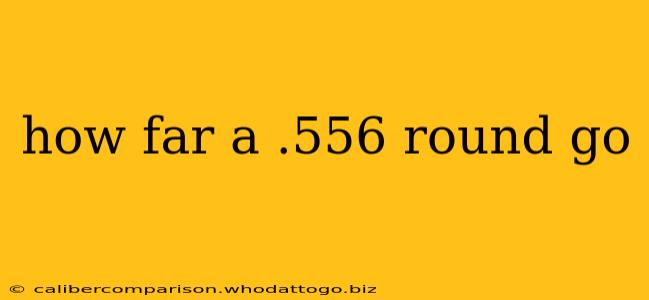The question "How far can a .556 round go?" doesn't have a simple answer. The effective range of a .556 NATO (or its civilian equivalent, the .223 Remington) cartridge is significantly different from its maximum range. Many factors influence how far a bullet will travel, making a precise answer impossible without specifying those variables.
Effective Range vs. Maximum Range: A Key Distinction
Let's clarify the terminology:
-
Effective Range: This refers to the distance at which a shooter can reliably hit a target with sufficient accuracy and power to cause incapacitation. For a .556 round, the effective range varies depending on the weapon, ammunition type, and the shooter's skill. Generally, the effective range is considered to be around 300-500 meters (approximately 330-550 yards) for a skilled marksman using a quality rifle. Beyond this distance, accuracy significantly decreases, making it difficult to consistently hit targets.
-
Maximum Range: This signifies the total distance a bullet can travel before it loses all its forward momentum and falls to the ground. This distance can be much greater than the effective range. For a .556 round fired from a standard rifle, the maximum range can extend to over 3,000 meters (approximately 3,300 yards), although it's important to note that at such distances, the bullet's energy and velocity are drastically reduced, posing minimal threat.
Factors Affecting .556 Round Distance
Several factors significantly impact the distance a .556 round travels:
1. Ammunition Type:
Different .556 rounds have varying bullet weights, designs (full metal jacket, hollow point, etc.), and powder charges, each affecting their ballistic performance. Heavier bullets generally travel shorter distances but retain more energy at longer ranges.
2. Weapon Platform:
The rifle used to fire the round influences its trajectory. A longer barrel allows for more complete powder burn, resulting in higher muzzle velocity and increased range. Conversely, shorter barrels reduce the bullet's initial velocity and maximum range.
3. Barrel Condition:
A clean, well-maintained barrel contributes to better accuracy and range. A fouled or damaged barrel can negatively impact the bullet's trajectory and distance.
4. Environmental Conditions:
Wind, temperature, humidity, and altitude all influence the path of a bullet. Headwinds reduce range, while tailwinds increase it. Higher altitudes and colder temperatures tend to result in longer ranges due to the thinner air.
5. Angle of Fire:
The angle at which the rifle is fired impacts the trajectory. Firing uphill increases the range, while firing downhill decreases it.
Safety Considerations: Beyond the Effective Range
It's crucial to understand that even beyond the effective range, a .556 round retains some residual energy. While its ability to inflict serious harm is significantly diminished at extreme distances, it's still dangerous. Always treat firearms with utmost respect and adhere to safe handling practices. Never fire a firearm unless you have proper training and understand the potential risks.
Conclusion
While a general range for a .556 round can be estimated, the precise distance depends on several interrelated variables. Understanding these factors and differentiating between effective and maximum range is essential for responsible firearms ownership and safe handling. Always prioritize safety and seek professional training before handling firearms.

